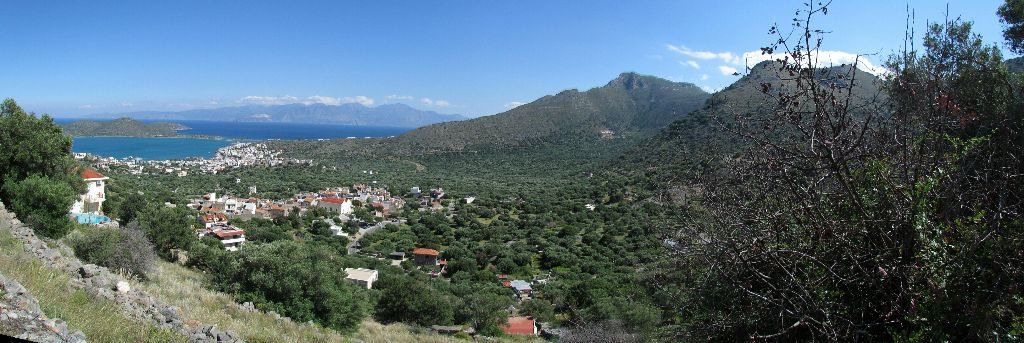Elounda
After a relaxing evening, our first night at anchor was rudely disturbed by the bilge pump at 5:30am. With memories of last summer’s leaking prop shaft still fresh in our mind, we broke the world record for fastest leap out of bed.
First check – yep, there was water in the bilge. Second take up the floor in the aft cabin and find it’s all dry there. Then the taste test…. The water was fresh so most likely we had a leaky water tank. Sometimes the flubbers under the saloon floor leak from their filler cap if it gets pushed up against the floor. Maybe on the journey here they’d moved around? A feel under the floors revealed no water nor any up forward so the culprit must be the water maker tank under the galley. It didn’t seem to be leaking quickly so back to bed to sort in the morning.
The fault turned out to be a leaking valve causing water to drain from our bow tank into the galley tank and overflow it. Amongst our hoarded collection of random gubbins we found a replacement valve which was swapped in for the leaky one. It did the job and no more overflowing tank.
The anchorage off Elounda was our home for a few days whilst we finished off setting up the boat and ironing out a few small snags. The dinghy was launched and reassembled, the dinghy davits attached and the water maker put into service. It’s a good place to do repairs with the sailor’s sweetie shop of Elounda chandlery just a short dinghy ashore.
Amongst the jobs we found time for some walks and celebrated leaving the marina with dinner out at The Hope. We were lucky to get the only unreserved table available – who knew it would have been so busy at this time of year? The food was great and we ate ourselves fuller than we have for a long time.
Saturday was unseasonably cold with rain all afternoon. Hibernation time!

View from a walk up the hill to Kato Elounda, an old village of cobbled walkways winding their way between rickety looking houses.
Spinalonga
Before we left Crete we wanted to see Spinalonga. We took the easy option of a boat ride rather than by dinghy. The cost was €10 per person return plus €8 entry to Spinalonga. A hit to the finances but we didn’t want to get caught in the dinghy in any winds like we had on the day of arrival. Our boat wasn’t full and the island wasn’t very busy either. Yesterday’s rain had cleared leaving a fresh feel to the air which the sun was slowly warming up.
We walked anticlockwise around, dinging the bell at St. George’s chapel on the way past to commemorate his saint day. Yellow and white giant daisys covered every available bit of land with splashes of red poppy. On the west side we arrived at the ruined houses; those from the Ottoman village and the later buildings built for the leper colony. Most of the houses had lost their roofs, a few beams hanging precariously in places. Walls had tumbled, doors hung crooked and across all of it the wild flowers ran rampant. They added brightness to a place with a sad history; standing by the imposing entrance gate I tried to imagine the despair the lepers would have felt on arriving here, uprooted from their homes and families and herded into the huge disinfection room within a former guard house.
Sitea
With all jobs sorted and visits completed we were ready to head onwards. Monday we upped anchor and motored to Sitea. I got to practise my coming alongside a wall manoeuvring with help fron Ron Glas on the lines.
Kasos
Sitea was an overnight pitstop with favourable winds the next day to take us on to Kasos. We would have to cross the notoriously windy and wild gap between Crete and Kasos but we chose a good day to do it with F4 to F5 winds from the north. Emerald romped across, sailing all the way from the tip of Crete to just off Fry.
Although the winds had eased right off there was still a northerly swell rolling in. We’d planned to go into the old harbour at Emborio but the swell at the entrance made me nervous. We decided to check out the new harbour but found the inner section of the mole filled up with a ferry boat, fishing boats and a refugee yacht. We got tied alongside the outer section but there was an uncomfortable up-down motion. Back to the old harbour then!
The entrance was fine and there was plenty of space and water to turn into. My worry that the swell would surf us into the rocks was thankfully unfoundered! Another coming alongside a wall manoeuvre went well and we were safely tied up, pointing out at the end nearest the entrance in 4m of water. We assisted Ron Glas who tied up behind us.
The harbour wall is a bit rough where sections have worn away and the bollards and rings are being eaten away by rust, but it felt pretty safe. The swell still had us gently lifting and falling so the fender board was essential.
What a beautiful spot! It felt like wild camping and as the sun set it turned the hillside a warming russet colour.
Kasos is the southernmost island in the Aegean and doesn’t receive as many visitors as it’s neighbouring islands. It can be a wild and windy place but we were blessed with light winds and sunshine for our time there. Over the next few days we explored the port village of Fry, Bouka, the former pirate harbour and the villages clustered on the hillsides. There was plenty of people about, the cafes were busy and everyone was so friendly and happy as preparations were made for the summer season. As we kalimera’ed our way along the roads even the cars and bikes that passed us waved or nodded and a donkey eeyored a welcome and ambled over for a scratch between the ears. The port police were very friendly when they came to visit and offered to move some of the boats in the new harbour if we wanted to go there (water and electricity is available there).
In the villages there are many abandoned and falling down houses, the population much reduced from past heights of 12,000 when a large fleet of trading ships brought significant profits to the island. Now around 1,800 live here, their houses painted a bright white with blue doors and windows.
And so many churches! The island website (www.kasos.gr) states there are 102 of them. And of those we saw, they were all kept in very good condition. There are even 6 churches all joined together, each doorway marked with the name of a different saint.
The water under Emerald was crystal clear. A bit too chilly still for swimming for me but a few hardy souls swam from the small beach at the back of the harbour.
We visited at a beautiful time of year with the wild flowers growing wherever they could. Fields, roadsides and rough ground were carpeted in colour. In a rubble strewn field we found Dragon Arums growing; one fully open and looking magnificent. The island is known for its fierce winds but they remained light whilst we were there and the sunsets cast a beautiful amber glow over the hills. We felt like we’d won the jackpot with our timing to visit.
Fry has most supplies you could need – several small supermarkets and hardware stores, two butchers, a fresh fruit and veg shop, baker and a post office. Just outside the town is a petrol station which is open in the mornings and late afternoon.
Sailing Info
24th April: Elounda to Sitea – 23nm travelled (3nm sailed) – Winds light WNW F3
Tied up alongside harbour wall in position 35 12.516’N 26 6.557’E
Berthing is free. Electricity and water available by token into machine. Sitea is a large town with supermarkets, bars, etc.
25th April: Sitea to Kasos – 46nm travelled (31nm sailed) – Winds from N F4 up to F6 for a time
Tied up alongside old harbour wall in Emborio in position 35 25.074’N 26 55.946’E
No charge to lie on the wall. There are no amenities in this harbour, although it may be possible to get water from the bar by the beach.
The wall is rough so a fender board is advisable. Bollards and rusty bars set into the wall to tie up to.
The new harbour has water and electricity available.
Shops selling fresh product in Fry, a 10 minute walk away. Prices were very good and around the same as we paid in Crete.



















